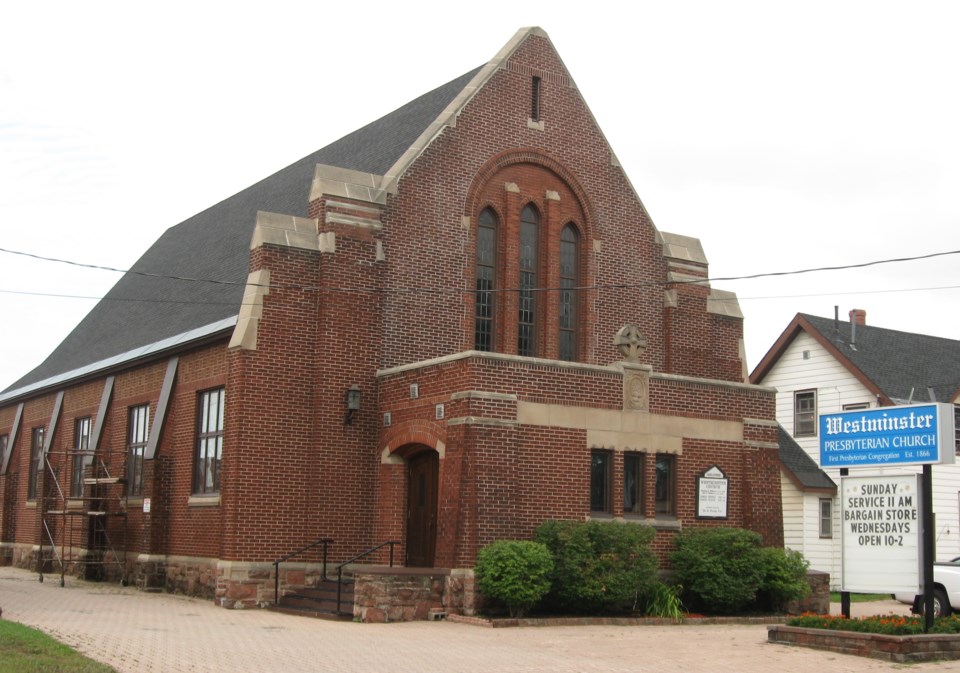From the archives of the Sault Ste. Marie Public Library:
*************************
Remember This? Westminster Presbyterian Church
In 1866 Sault Ste. Marie was a very small village but about eight families were able to form the first Presbyterian congregation under the name of St. Andrew’s Presbyterian Church. They immediately began meeting in an old school north of Wellington Street between Church and Pim Streets. After about 4 years they moved their meeting location to Dawson’s Hall and rented space from Mr. John Dawson. By 1874 a location had been chosen to build a church on land donated by Mr. Henry Pilgrim. A church was soon built on the site of the current St. Andrew’s United Church on Wellington Street at the head of East Street with seating for about 70 people. The city (and the church) continued to grow with many changes over the years. In 1925 a vote was held by the local congregation to determine whether they would join with the newly formed United Church of Canada. In a close vote of 399 to 329 St. Andrew’s voted to join the United Church of Canada. The result of this vote meant that about half of the congregation chose to continue with the Presbyterian Church of Canada so they formed Westminster Presbyterian Church.
For the past 90 years, the current Westminster Presbyterian Church has been located on the corner of Albert Street and Brock Street and can trace many aspects of its design back to Scotland. This church was built in 1926 in a Gothic Revival style at a cost of about $52,000. The architects, Claude Alexander Findley and James Foulis were Scottish emigrants who were strongly influenced in their architectural designs by a well-known Scottish architect, Charles Rennie MacIntosh. At the time these two architects lived in the Sault and were members of this church. The project was put out to tender and the contract was awarded to Hartman and Co. to build a church with a seating capacity of 512.
One of the most striking features that people notice about Westminster Presbyterian Church is the Celtic cross found on the front façade of the church. The cross represents the church’s Scottish heritage. Below the cross is a burning bush. This is a symbol of the Presbyterian Church in Canada with the motto, ‘And the Bush was not consumed’ depicting the moment when God spoke to Moses from the bush and appointed him to lead the Israelites out of Egypt and into Canaan in the book of Exodus. When the church was constructed it was decided to use brick on the interior arches as well as on the outside of the building. The use of brick on the interior was considered to be a rather innovative design concept at the time but it also proved to be a very economical approach that ensured that the building costs were kept within a reasonable range. With the onset of the Great Depression, this proved to be a very significant decision.
By 1952, the church was in need of additional space and a new wing was added providing space for a kitchen, a hall and space for Sunday School. In 1960, another addition was completed on the south-east corner. Designed by Jules Paivo, this new addition provided space for a vestry, meeting room, office, nursery and the auxiliary.
Music has always been a focal point for church worship. Westminster received a three-manual pipe organ in 1936 which was donated by Florence Cameron Gray in memory of her husband George. This organ was built by Casavant Freres of St. Hyacinthe, Quebec and had been purchased for $15,000 in 1936. After being completely refurbished in 1989, the organ was later estimated to have a value of over $300,000. A Beckstein grand piano was also donated to the church in memory of Lorraine Hamilton in 1980.
A stained glass window project, which has been referred to as Murals of Light is a recent addition to the church. The set of nine stained glass windows depict the life of Christ and the birth of the church and were designed by local artist, Barb Fournier. The design and installation of these windows occurred over a number of years, beginning around 1993 with the first window being dedicated in 1996. By 1999 five of the nine windows had been completed. The artist indicated in a Sault Star article from 1999 that she designed the murals in “almost abstract features, each employing a simple arched motif that is the church’s sole architectural flourish.” The new windows were a welcome addition to the church.
Westminster Presbyterian Church can be very proud of its long history in the city.
*************************
Each week, the Sault Ste. Marie Public Library and its Archives provides SooToday readers with a glimpse of the city’s past.
Find out more of what the Public Library has to offer at www.ssmpl.ca and look for more Remember This? columns here
